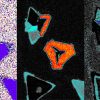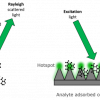Spectroscopy Applications
Confocal Raman imaging is an ideal method for studying 2D materials. It can be used to discern the orientation of their layers and investigate defects, strain and functionalisation.
A quadrupole mass spectrometer is a convenient and powerful method of measuring and monitoring both the compartment integrity and also the chemical composition of the atmosphere in gloveboxes.
Spinsolve 43 MHz systems can be equipped with a unique temperature control system that allows measurement at elevated temperatures without requiring nitrogen or dry air supply.
Low-field (benchtop) NMR is sufficient to offer the possibility of a method to detect adulteration of Arabica by robusta.
A UAV-based multi-camera system to collect NIR/SWIR data, to prove more robust and better-performing estimators of biomass monitoring.
The spectroscopically resolved version of PGSTE makes it possible to measure the diffusion coefficient of different molecules in a mixture by measuring the diffusion attenuation of the signal of each particular chemical group of each molecular structure.
The use of VOCs as a real-time marker in human breath for physiological events such as lactate threshold, and oxidative stress is a challenge for conventional “off-line” gas analysis equipment, such as GC/MS. The analysis necessitates very fast response, coupled with a wide dynamic range. The HPR-20 TMS Transient mass spectrometer is ideal for this application due to the fast response, wide dynamic range and high sensitivity offered by the PIC detector.
Minimal or no sample preparation and quick data generation allows the deployment of benchtop NMR in QA/QC environments without the need for operation by R&D scientists.
Rigaku Analytical Devices has published a new application report describing the use of handheld 1064 nm Raman analysers for a variety of applications involved in the manufacture and testing of hand sanitiser.
This application note uses Raman spectroscopy to investigate three polymers, polyethylene (PE), polytetrafluoroethylene (PTFE) and nylon-6.
Robust and reliable analytical methods are essential in the food industry to ensure that products are sold free of adulteration and safe for human consumption. Food crime is defined as “serious fraud and related criminality in food supply chains”. This description covers a broad range of activities from theft to document fraud, and Raman spectroscopy can be useful in detecting the adulteration and substitution aspect of food crime. Raman spectroscopy’s unique fingerprint-like spectrum can be used to identify adulterants rapidly and reproducibly.
A new application report from Applied Rigaku Technologies presents a method for the investigation of unknown sample materials by EDXRF for industrial forensics analyses.
Electron Multiplying CCD (EMCCD) cameras can be used to detect very weak signals, which would otherwise be lost within the noise floor of the camera.
The size aggregation of nanoparticles are studied in this application note for the optimisation of SERS for glucose sensing.
The reduction of PtVI to PtII in chemotherapy drugs is studied in this application.
The measurement of fluorescence lifetimes provides a wealth of information on the sample under study.
A new application report from Applied Rigaku Technologies details the elemental analysis of carbon black and related products by energy dispersive X-ray fluorescence.
Engineering new materials with unique and valuable electronic and optical properties is paramount in the design of new devices from memory storage to creating the next generation of photovoltaic solar cells. Having the ability to measure and quantify the energies and lifetimes of photo-generated excited states is of utmost importance in the design of molecules that possess the desirable traits needed for these applications.
The most important parameter to consider in compounding hand sanitiser is the alcohol content. It has also been determined that hand sanitiser with alcohol concentration below 60% (v/v) is not effective and could leave the user at higher risk of infection. This application note describes the use of FT-IR spectroscopy to determine ethanol and isopropanol in hand sanitiser.
NIR spectroscopy analysers can be used in the field to correctly identify species of similar-looking fish.




















